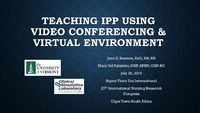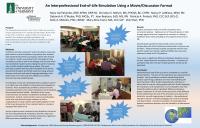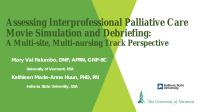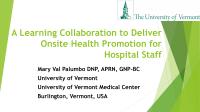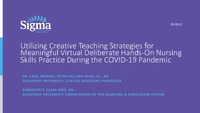| dc.description.abstract | <p>Session presented on Monday, July 25, 2016:</p>
<p><strong>Purpose:</strong> The purpose of this study was to explore student experiences in utilizing the virtual environment and videoconferencing in interprofessional education and practice through qualitative analysis. The goal of this presentation is to present these findings, discuss interprofessional education, and lessons learned including issues of applicability.</p>
<p><strong>Methods:</strong> A virtual environment and video conferencing was used for teaching interprofessional practice (IPP) when caring for the elderly with students from eight healthcare professions. Students from nursing, physical therapy, speech and language therapy, social work, nutrition, medicine, exercise science, and pharmacy collaboratively developed a plan of care for a frail elder. The virtual environment was a clinic where students used avatars to interview a frail elder and family. After completing the interviews, interprofessional video conferences (90 minutes in length) were conducted. In previous reports, quantitative analysis revealed that more than 60% of students strongly agreed on the value of the experience. Following the video conference students completed an evaluation survey that was developed using Interprofessional Competency Domains (Interprofessional Education Collaborative Expert Panel, 2011) and included 14 Likert-scaled, five open-ended, and demographic questions. The survey was reviewed by a panel of experts to assure content validity. No reliability testing was done. A qualitative analysis was performed on students' comments from the 5 open ended questions. The questions asked were: was the virtual clinic valuable, what went well, what could be improved, how could it be structured differently, and was the videoconference valuable. All students answered each open-ended question therefore the questions themselves provided an organizing structure (Patton, 1990), from which analytical files were created (Glesne, 1999). For example, the first question "was the virtual clinic interview a valuable experience? Why or why not?" became an analytical file. The data were then coded and categorized into themes (Glesne, 1999), and organized into realist tales (VanMaanen, 1988). Trustworthiness is a term used in qualitative research to address validity and reliability of the findings (Glesne & Peshkin, 1992). Or in other words, can the reader trust the analysis to be true. To address bias, direct quotes (realist tales) are used throughout so the reader can judge for themselves the truth of the data. The analysis was shared with the second author and consensus was reached on the coding.</p>
<p><strong>Results:</strong> Participants (n=75) were predominantly female (77%) and white/Caucasian (83%) and students in eight health care professional programs. Two of the five open ended questions asked whether the virtual clinic and the videoconference were valuable, yes/no, with a request for comments. For both questions respectively 52/53 out of respondents said yes, 4/5 said no, and 10/11 said yes and no. The categories and codes resulting from questions about what went well, what could be improved and how might it be structured differently were the same and so collapsed into 3 themes: technology, interprofessional practice, and set-up. Technology included an appreciation of its use in practice, especially videoconferencing. Common frustrations in the technology included lack of speed, inadequate internet service, and hardware/software issues. Interprofessional practice included learning about other professions, collaborative teaming, and gaining broader insights. The set-up theme included use of meetings roles and agendas for the videoconference, the importance of the facilitator role, planning and preparation for the experience, and the sequencing of the whole experience. Issues related to set-up included ensuring that at videoconferences there is 1 student per discipline (some participated in groups or even a whole class of students). Some still preferred face to face, but these were a small number: 5/68 respondents. These same themes emerged for the question relating to the value of the virtual clinic interview. Two additional themes emerged from that question as well: Diversity/person-centered care and experience gained. The virtual interview offered students choices in questions, and they chose incorrectly the rationale popped up. When they chose correctly the patient answered the question and the interview proceeded. The students appreciated being able to learn interview skills. Because the virtual patient was a Korean elder, faculty was able to embed knowledge and skills in culturally responsive care into the entire experience. Many students valued this aspect of the virtual clinic experience. For the question related to the value of the videoconference, the same three themes also emerged from the data. A third theme, dynamic learning, emerged as well. Dynamic learning encompassed a learning of the power of interprofessional practice, a determination to use it in their future practice and a great appreciation for the skill building experience.</p>
<p><strong>Conclusion:</strong> The overwhelming majority of students felt the virtual clinic and videoconferencing was a valuable experience. They felt like they gained skill in interprofessional practice, learned more about what other professions bring to a team, and valued the interprofessional discussion which focused on patient-centered goals rather than discipline specific goals. Most recognized the usefulness of the technology, although there were technology glitches and limitations mentioned. Specifically, participants wanted a visual aid that accompanied the interprofessional discussion, such as a note taking visual on the videoconferencing platform that all participants could see while the conversation was occurring. The value of the virtual clinic interview was mentioned in that IPP students gained skill in patient/family-centered and culturally responsive interviewing. Students saw the importance of videoconferencing in their future practices, and gained skill in how to use this technology as a member of an interprofessional team. Significance to nursing and other health professionals' pre-service education cannot be overstated. Interprofessional practice is an essential element to addressing complex health needs and education must instill this (Health Professions Network Nursing and Midwifery Office within the Department of Human Resources for Health, 2010). It is extremely important for students to gain knowledge and skill in interprofessional collaboration before they are thrust into situations for which they are not prepared. Further research involving IPP educational pedagogy and the use of distance technologies is needed. Faculty acceptance for using this technology and solving technology related problems should also be explored.</p> | en |
